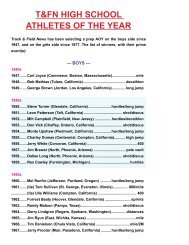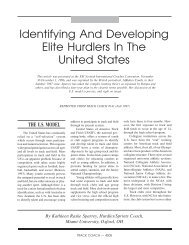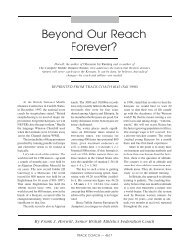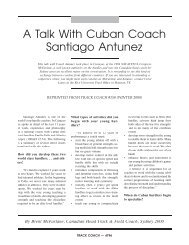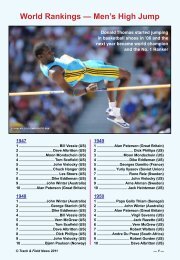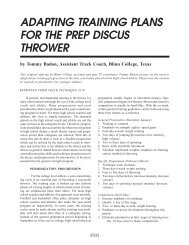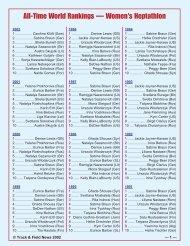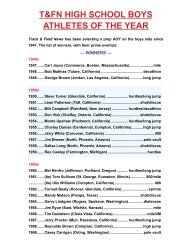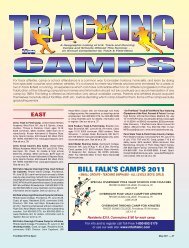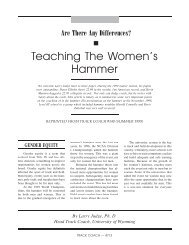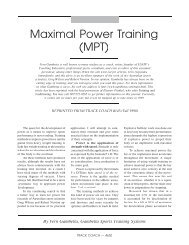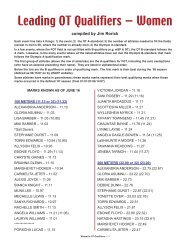SPEED TRAINING - Track & Field News
SPEED TRAINING - Track & Field News
SPEED TRAINING - Track & Field News
Create successful ePaper yourself
Turn your PDF publications into a flip-book with our unique Google optimized e-Paper software.
Upper body relaxation can also be trained at the same<br />
time. It may be productive to emphasize individual form<br />
facets during acceleration and within a repetition, and<br />
then try to put everything together. Facets that can be<br />
emphasized: leg-foot drive, leg pull-through (recovery),<br />
allowing full knee lift, stabbing the foot to the ground<br />
quickly, and upper body form and relaxation.<br />
RELAXATION<br />
“Relaxed” sprinters sprint better. Being able to turn<br />
muscle contractions on and off very quickly is the essence<br />
of sprinting. As such, it allows the next contraction to take<br />
place without “tension,” which can hinder the speed and<br />
force of the contraction. 9<br />
Relaxation probably has inherent or genetic factors,<br />
but it can be aided through training. Like any learning<br />
process, for relaxation to become second nature, it must<br />
be practiced and concentrated on during sprinting. The<br />
athlete must concentrate on both individual muscle groups<br />
and total body relaxation. This can be a part of everyday’s<br />
sprinting.<br />
There is a second factor to relaxation. This involves<br />
learning to relax and visualize the process of sprinting<br />
and the race (useful in all events). Perceiving a positive,<br />
successful performance reduces “race” tensions, anxiety,<br />
and any apprehensions.<br />
The procedure varies slightly, but it can proceed as<br />
follows, and can be done anytime, especially the day prior<br />
to or the day of competition: find a quiet, comfortable place<br />
to lie down; starting with the feet, contract and relax all<br />
the muscle groups, alternately, from toe to head; relax the<br />
entire body; visualize all aspects of the race in a positive<br />
way (winning—performing movements correctly) from<br />
warm-up to finish line.<br />
If done with the aid of a coach, his or her use of a<br />
monotone, hypnotic voice is beneficial (see Relax And Win,<br />
by Bud Winter). Relaxed, positive, pre-race visualization<br />
of the event has been shown to have a positive effect on<br />
the stopwatch.<br />
TESTING<br />
Tests for power, strength, speed, speed endurance,<br />
and starting mechanics can be useful in isolating weaknesses<br />
and individualizing the program to address such<br />
weaknesses.<br />
Currently, we use the following tests, and test at the<br />
beginning or end of each cycle, or as needed for each<br />
athlete:<br />
30m flying start*<br />
tests for speed<br />
60m crouch start* tests for speed endurance (alactic)<br />
30m crouch start* tests for starting mechanics<br />
300m speed endurance more specific to 400m<br />
Body Fat% (underwater weighing) tests fat%<br />
& excess weight levels<br />
Standing Long jump<br />
tests for power<br />
*We use the standards developed by Petrovskiy.<br />
For the other tests we either use our own standards<br />
or those developed by the USOC/TAC Elite Athlete Project.<br />
We are considering the use of other tests, as we determine<br />
those which are most predictive and beneficial to<br />
measuring and improving athlete performances.<br />
We do not always give every test at each testing<br />
session/cycle. Rather, we use athlete progress and performances<br />
to dictate the area of testing. Also, competitive<br />
performances often furnish better results in the competitive<br />
season than tests such as these. Some of the tests are given<br />
within a cycle when indicated (e.g., athlete weight gain,<br />
speed or speed endurance when a weakness is indicated).<br />
Unfortunately, good weather and good facilities are a must<br />
for comparing test results to standards. Therefore, we find<br />
meet results more useful during the early competitive season<br />
(late November to early April are our cool weather<br />
months).<br />
The basic Petrovskiy standards are listed below. For<br />
a given performance expectation in the 100 or 200, all<br />
three measurements should be at the same level. When<br />
the 30m CS, 30m ES, and 60m CS are at different levels<br />
it indicates a weakness (or perhaps strength) in one or<br />
more of the areas.<br />
30m FS 30m CS 60m CS l00m CS 200m CS<br />
3.3 4.3 7.6 12.0 24.5<br />
3.2 4.2 7.4 11.6 23.8<br />
3.1 4.1 7.2 11,3 23.2<br />
3.0 4.0 7.0 11.1 22.5<br />
2.9 3.9 6.9 10.9 22.0<br />
2.8 3.8 6.8 10.7 21.4<br />
2.7 3.7 6.7 10.5 21.0<br />
2.6 35 6.6 10.3 20.4<br />
2.5 3.5 6.5 10.1 20.2<br />
CS=crouch start<br />
FS=flying start<br />
Standing Long Jump Standard: 8’2” or better.<br />
Body Fat % Standard(s): 6-12%.<br />
SUMMARY AND PERIODIZATION<br />
Coaching is a continuous learning process. We try<br />
to use the best available information and technology<br />
3292



